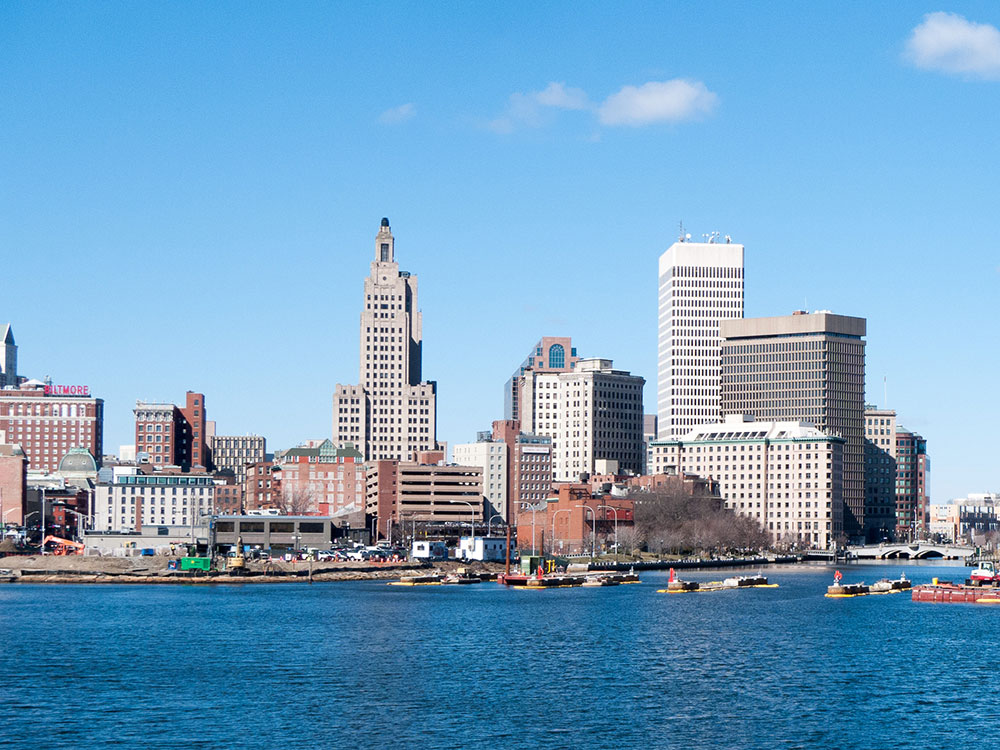Capital and most populous city in Rhode Island and one of the oldest cities in the United States
Places to See in Providence, RI
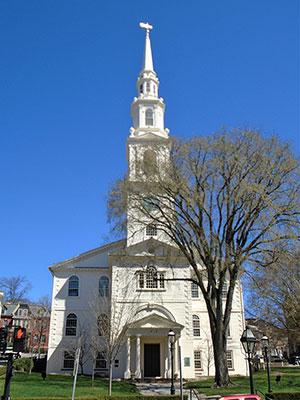
Beyond My Ken, CC BY-SA 4.0, via Wikimedia Commons; Image Size Adjusted
First Baptist Church in America
Oldest Baptist church congregation in the United States, founded in 1638 by Roger Williams in Providence
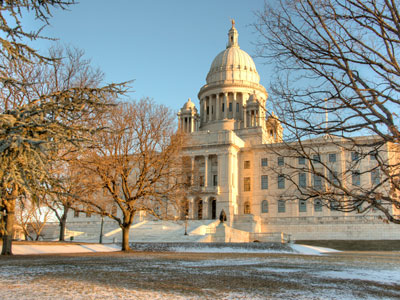
Bestbudbrian, CC BY-SA 3.0, via Wikimedia Commons; Image Size Adjusted
Rhode Island State House
Neoclassical building which features the fourth largest structural-stone dome in the world
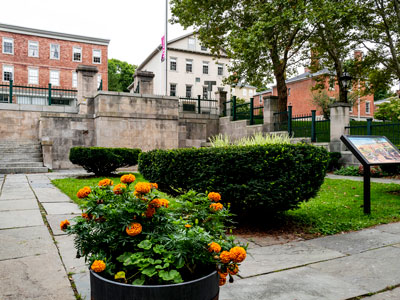
Bags27, CC BY-SA 4.0, via Wikimedia Commons; Image Size Adjusted
Roger Williams National Memorial
Landscaped urban park commemorates the life of Roger Williams who co-founded the Colony of Rhode IslandNeoclassical building which features the fourth largest structural-stone dome in the world

Adnan Islam, CC BY 2.0, via Wikimedia Commons; Image Size Adjusted
WaterFire
Sculpture featuring a series of bonfires lit on the river accompanied by classical and world music presented in downtown Providence
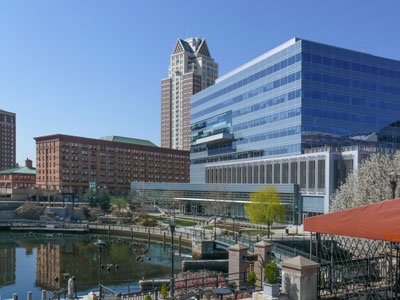
David Wilson, CC BY 2.0, via Wikimedia Commons; Image Size Adjusted
Waterplace Park
Urban park situated along the Woonasquatucket River in downtown Providence and connected to 3/4 mile of cobblestone-paved pedestrian walkways along the waterfront known as Riverwalk
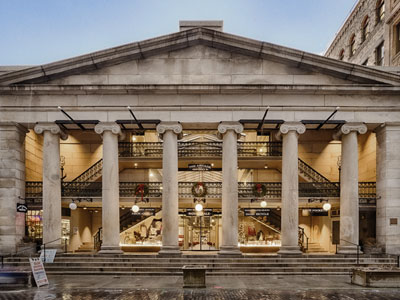
Timothy Burling, CC BY 2.0, via Wikimedia Commons; Image Size Adjusted
Westminster Arcade
Historic shopping center in downtown Providence notable as the first enclosed shopping mall in the United States and as an example of commercial Greek Revival architecture
Providence is the capital and most populous city in Rhode Island and is one of the oldest cities in the United States. It was founded in 1636 by Roger Williams, a Reformed Baptist theologian and religious exile from the Massachusetts Bay Colony. He named the area in honor of "God's merciful Providence" which he believed was responsible for revealing such a haven for him and his followers. The city is situated at the mouth of the Providence River at the head of Narragansett Bay.
Providence was one of the first cities in the country to industrialize and became noted for its textile manufacturing and subsequent machine tool, jewelry, and silverware industries. Today, the city of Providence is home to eight hospitals and seven institutions of higher learning which have shifted the city's economy into service industries, though it still retains some manufacturing activity.
Providence is located at the head of Narragansett Bay, with the Providence River running into the bay through the center of the city, formed by the confluence of the Moshassuck and Woonasquatucket Rivers. The Waterplace Park amphitheater and riverwalks line the river's banks through Downtown.
Downtown Providence has numerous 19th-century mercantile buildings in the Federal and Victorian architectural styles, as well as several postmodern and modernist buildings. In particular, a fairly clear spatial separation appears between the areas of pre-1980s development and post-1980s development; West Exchange Street and Exchange Terrace serve as rough boundaries between the two.
The streetscape of much of historic Downtown has retained a similar appearance since the early 20th century. Many of the state's tallest buildings are found here. At 426 feet (130 m), the city's largest structure is the art deco Industrial National Bank Building. The building contrasts with the city's second tallest structure—One Financial Plaza—which is designed in the modernist style. Other core buildings of the Providence skyline are the postmodern 50 Kennedy Plaza and late modern Textron Tower. Downtown is also the home of the historic Providence Biltmore hotel and Westminster Arcade—the oldest enclosed shopping mall in the U.S.
During the summer months, the city regularly hosts WaterFire, an environmental art installation that consists of about 100 bonfires which blaze just above the surface of the three rivers that pass through the middle of Downtown Providence. There are multiple Waterfire events that are accompanied by various pieces of classical and world music.
- Roger Williams National Memorial
- Roger Williams Park
- Prospect Terrace Park
- Rhode Island School of Design Museum
- Old Stone Bank
- Providence Athenæum
Providence is home to a 1,200-acre (4.9 km2) park system. Notable among these are Waterplace Park and the Riverwalk, Roger Williams Park, Roger Williams National Memorial, and Prospect Terrace Park. Prospect Terrace Park features expansive views of the downtown area, as well as a 15-foot tall granite statue of Roger Williams gazing over the city. As one of the first cities in America, Providence contains many historic buildings, while the East Side neighborhood in particular includes the largest contiguous area of buildings listed on the National Register of Historic Places in the U.S., with many pre-revolutionary houses.
Providence's East Side is also home to the First Baptist Church in America, which was founded by Williams in 1638, as well as the Old State House which served as the state's capitol from 1762 to 1904. Nearby is Roger Williams National Memorial. The dome of the State House is the fourth-largest self-supporting marble dome in the world and the second-largest marble dome after St. Peter's Basilica in Rome.
The Rhode Island School of Design Museum contains the 20th-largest collection in the United States. The Providence Athenæum is the fourth oldest library in the United States, in addition to the Providence Public Library and the nine branches of the Providence Community Library. Edgar Allan Poe frequented the library, and met and courted Sarah Helen Whitman at the library. H. P. Lovecraft was also a regular patron.
The Bank Newport City Center is located near Kennedy Plaza in the Downtown district, connected by pedestrian tunnel to Waterplace Park, a cobblestone and concrete park below street traffic that abuts Providence's three rivers. Another Downtown landmark is the Providence Biltmore, a historic hotel which stands adjacent to Kennedy Plaza.
The southern part of the city is home to the famous roadside attraction Nibbles Woodaway (also known as the "Big Blue Bug"), the world's largest termite. Roger Williams Park contains a zoo, a botanical center, and the Museum of Natural History and Planetarium.
The city serves as the end point for four of the state's major traffic-free bicycle paths: the East Bay Bike Path, Washington Secondary Rail Trail, the Woonasquatuck Greenway Bike Path, and the Blackstone River Greenway. There are several dedicated on-road bicycle lanes within the city.
In August 2019, a pedestrian bridge opened, spanning the Providence River and connecting Providence's east and west sides. The bridge was constructed on the granite piers of the old Route 195 bridge.
This article uses material from the Wikipedia article "Providence, Rhode Island", which is released under the Creative Commons Attribution-Share-Alike License 3.0
